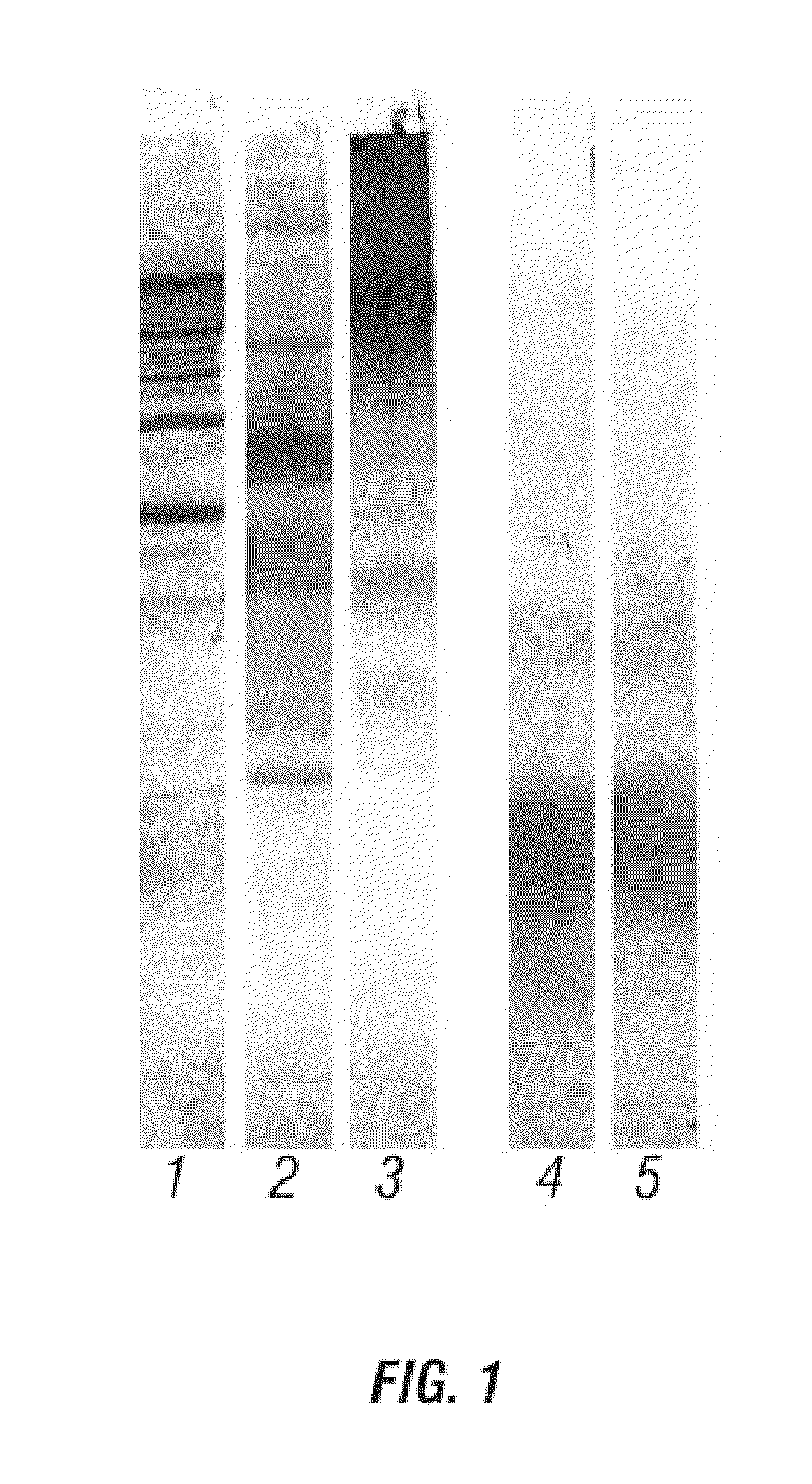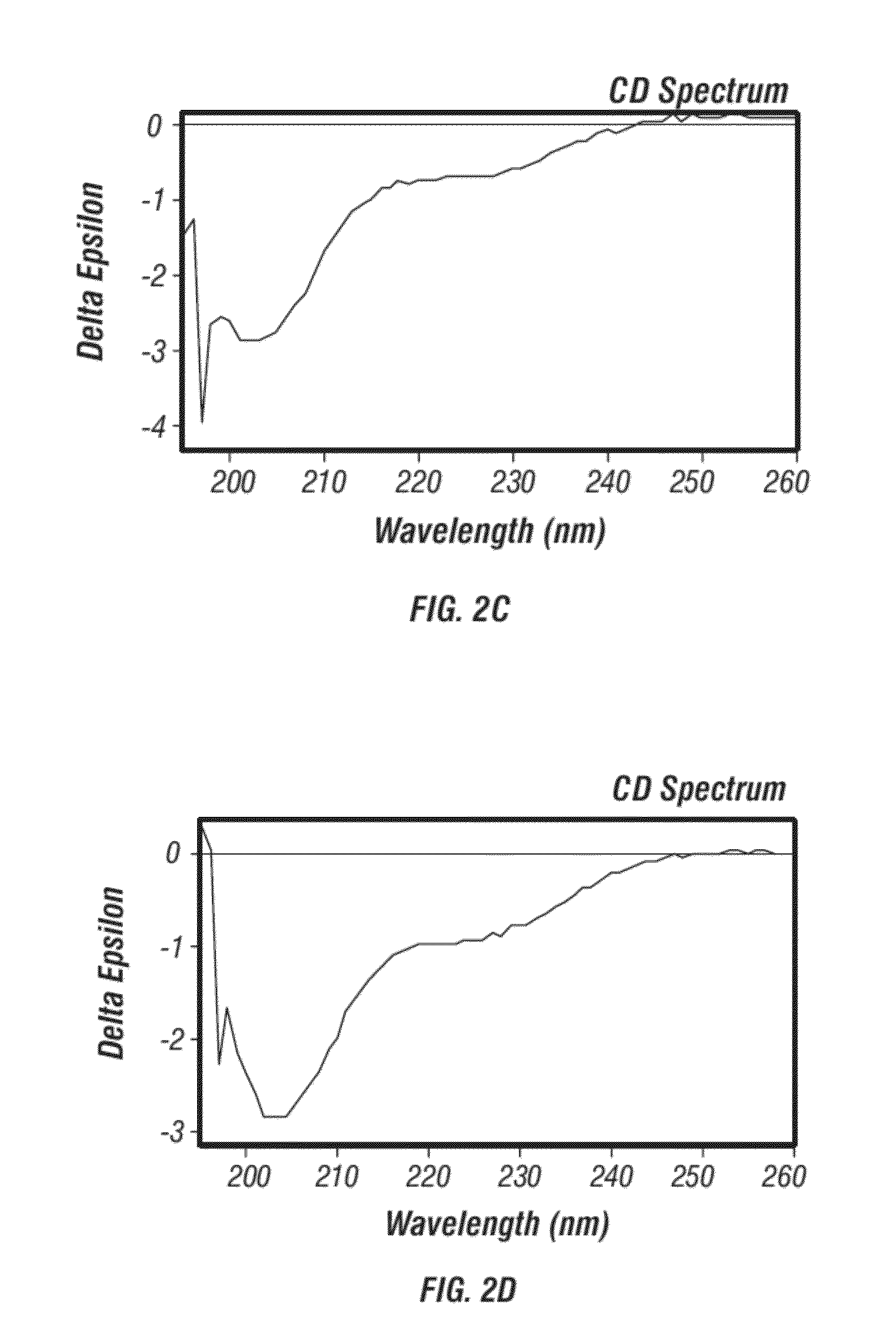Modification of Allergens for Immunotherapy
a technology for immunotherapy and allergens, applied in the field of immunotherapy pharmaceutical compositions, can solve the problems of difficult allergy treatment, time-consuming, new allergen reaction, etc., and achieve the effect of effectively desensitizing the individual to the allergen, reducing or preventing the production of specific-ige antibodies
- Summary
- Abstract
- Description
- Claims
- Application Information
AI Technical Summary
Benefits of technology
Problems solved by technology
Method used
Image
Examples
example 1
Peanut Protein Extraction and Purification
[0132]Peanut extract was prepared using commercially available peanut meal. Purified Ara h1 and Ara h 2 are available at TNO (Zeist, The Netherlands) and described in detail by Koppelman et al., Clin. Exp. Allergy, April 2005, 35(4):490-7.
[0133]In short, lyophilized crude peanut extract (CPE) was dissolved in 20 mM TRIS-bis-propane, pH 7.2 (TBP) to a final concentration of 1 mg / mL. Undissolved particles were removed by centrifugation (3000×g, 15 min) and the solution was applied on a 8 mL Source Q column (1×10 cm) previously equilibrated with TBP. After washing the column with 80 mL of TBP, a linear gradient of 200 mL (0-1 M NaCl in TBP) was applied to elute the bound proteins (2 mL / min). To remove traces of peanut lectin from Ara h2 (less than 1%), Ara h2 was dialysed against 50 mM NaAc, pH 5.0 and loaded on a 1 mL Source S column (0.5×5 cm) equilibrated with 50 mM NaAc, pH 5.0. After washing with 10 mL of 50 mM NaAc, pH 5.0, the column was...
example 2
Materials and Methods
Test Proteins
[0190]Crude peanut extract (CPE) was prepared from ground peanut (Arachis hypogaea, variety: Runner) as described earlier [Koppelman et al., 2001]. Ara h1, Ara h2, Ara h3, and Ara h6 were purified as described earlier [de Jong et al., 1998; Koppelman et al. 2003, Koppelman et al., 2005]. N-terminal sequencing was performed by Edman degradation, using bands excised from SDS-PAGE gels (SeCU, Utrecht, The Netherlands).
[0191]Porcine pepsin was purchased from Sigma (St. Louis, Mo., USA, # P-6887). This product was chosen because it has the highest specific activity commercially available (3300 U / mg for this particular batch), and because other researchers investigating the digestibility behavior of potentially allergenic proteins use this product [Thomas et al, 2004]. Trypsin from bovine pancreas (treated with L-1-Tosylamide-2-phenylethyl chloromethyl ketone (TPCK) to reduce the chymotrypsin activity) was obtained from Sigma (T-1426). The protea...
example 3
Production of Ara h2 / Ara h6 Preparations
[0248]Peanut acetone powder (150 g, Greer laboratories) was suspended in Tris / HCl buffer (1.5 L, 50 mM) and the suspension was stirred for 1.5 h at room temperature. The suspension was thereafter filtered over a Buchner funnel with a Sefar 07-20 / 13 filter yielding a solution of 1100 ml. The solution was then filtered through depth filters and subsequently through a 0.2 μm filters yielding the undiluted CPE solution (830 ml). The latter solution was then diluted with Tris / HCl buffer (3160 ml, 50 mM, pH8). Anion exchange chromatography was used to purify Ara h2 and Ara h6 from the peanut extract. Therefore, a 93 ml Q Sepharose X1 column was equilibrated with Tris / HCl buffer (190 ml, 50 mM, pH 8). The peanut extract was then applied to the column at a flow rate of 20 ml / min. The column was thereafter washed with Tris / HCl buffer (270 ml of 50 mM) and eluted with 50 mM Tris / HCl+200 mM NaCl (700 ml, pH 8). Finally, 640 ml of solution was collected, ...
PUM
 Login to View More
Login to View More Abstract
Description
Claims
Application Information
 Login to View More
Login to View More - R&D
- Intellectual Property
- Life Sciences
- Materials
- Tech Scout
- Unparalleled Data Quality
- Higher Quality Content
- 60% Fewer Hallucinations
Browse by: Latest US Patents, China's latest patents, Technical Efficacy Thesaurus, Application Domain, Technology Topic, Popular Technical Reports.
© 2025 PatSnap. All rights reserved.Legal|Privacy policy|Modern Slavery Act Transparency Statement|Sitemap|About US| Contact US: help@patsnap.com



